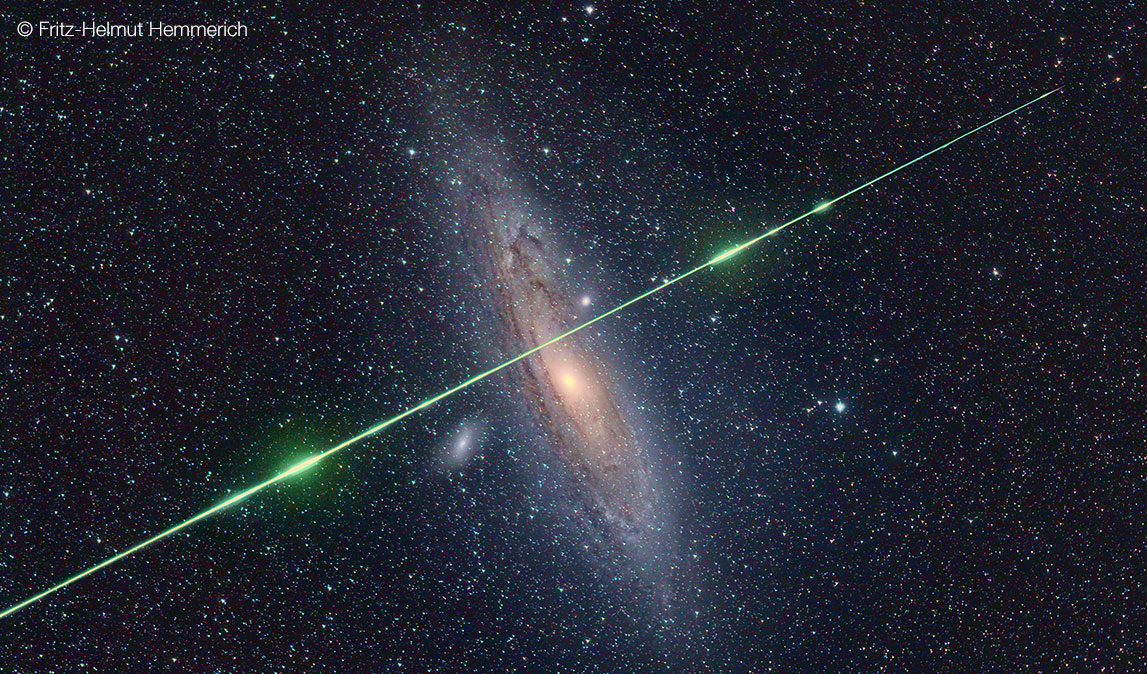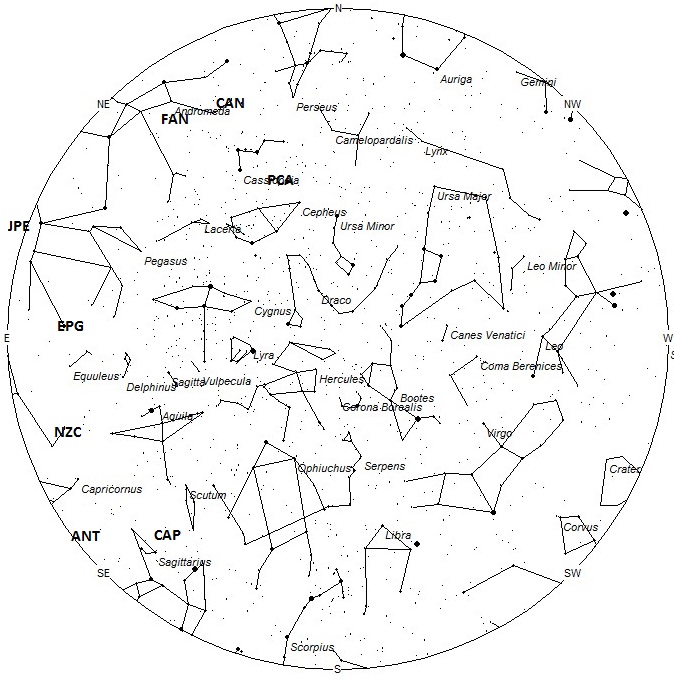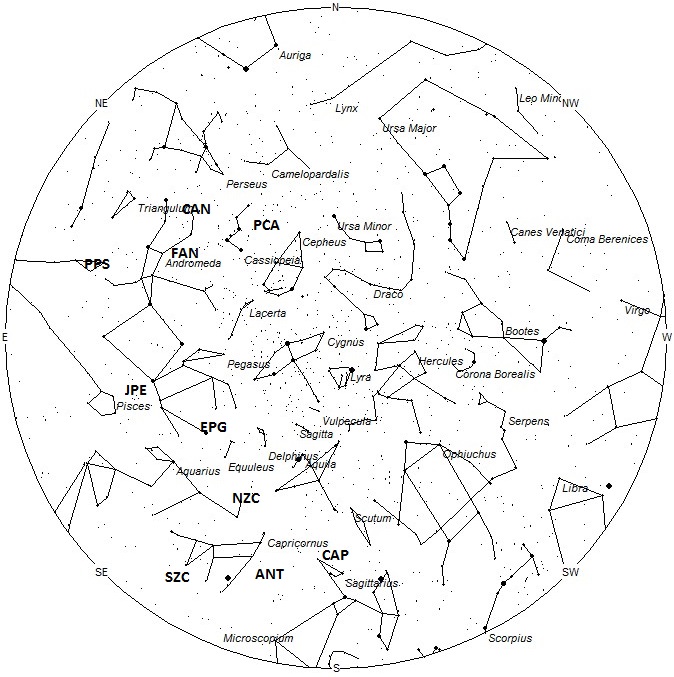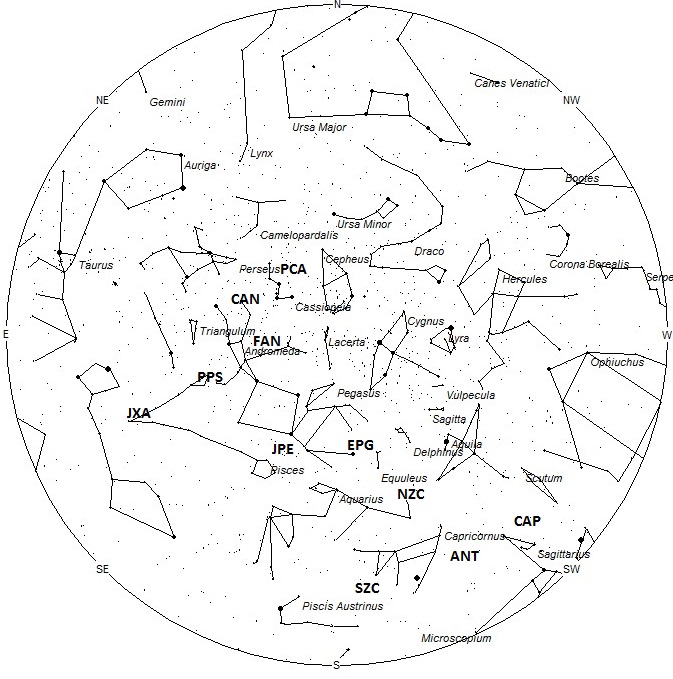
During this period the moon will reach it’s new phase on Thursday July 12th. At that time the moon will be located near the sun and will be invisible at night. This weekend the waning crescent moon will rise during the early hours and will not interfere too much with viewing meteor activity as long as you keep it out of your field of view. The estimated total hourly meteor rates for evening observers this week is near 2 as seen from mid-northern latitudes and 3 for those viewing from subtropical southern latitudes (25S). . For morning observers the estimated total hourly rates should be near 12 for those viewing from mid-northern latitudes and 16 for those viewing from subtropical southern latitudes (25S). Rates during this period are slightly reduced by interfering moonlight. The actual rates will also depend on factors such as personal light and motion perception, local weather conditions, alertness and experience in watching meteor activity. Note that the hourly rates listed below are estimates as viewed from dark sky sites away from urban light sources. Observers viewing from urban areas will see less activity as only the brighter meteors will be visible from such locations.
The radiant (the area of the sky where meteors appear to shoot from) positions and rates listed below are exact for Saturday night/Sunday morning July 7/8. These positions do not change greatly day to day so the listed coordinates may be used during this entire period. Most star atlases (available at science stores and planetariums) will provide maps with grid lines of the celestial coordinates so that you may find out exactly where these positions are located in the sky. A planisphere or computer planetarium program is also useful in showing the sky at any time of night on any date of the year. Activity from each radiant is best seen when it is positioned highest in the sky, either due north or south along the meridian, depending on your latitude. It must be remembered that meteor activity is rarely seen at the radiant position. Rather they shoot outwards from the radiant so it is best to center your field of view so that the radiant lies near the edge and not the center. Viewing there will allow you to easily trace the path of each meteor back to the radiant (if it is a shower member) or in another direction if it is a sporadic. Meteor activity is not seen from radiants that are located far below the horizon. The positions below are listed in a west to east manner in order of right ascension (celestial longitude). The positions listed first are located further west therefore are accessible earlier in the night while those listed further down the list rise later in the night.
These sources of meteoric activity are expected to be active this week.
The alpha Capricornids (CAP) are active from July 3 through August 11 with maximum activity occurring during the last week of July. The broad maximum occurs anywhere from July 25 to the 30th with visual rates usually around 3 per hour. The radiant is currently located at 18:56 (284) -15, which places it in southeastern Scutum, 6 degrees north of the 4th magnitude star known as xi 2 Sagittarius. This radiant is best placed near 0100 local summer time (LST), when it lies on the meridian and is located highest in the sky. Hourly rates at this time should be less than 1 as seen from mid-northern latitudes and 1 as seen from tropical southern latitudes. With an entry velocity of 22 km/sec., the average alpha Cap meteor would be of slow velocity.
The center of the large Anthelion (ANT) radiant is currently located at 19:52 (298) -21. This position lies extreme eastern Sagittarius, 15 degrees west of the brilliant planet Mars. This radiant is best placed near 0200 LST, when it lies on the meridian and is located highest in the sky. Hourly rates at this time should be near 1 as seen from mid-northern latitudes and 2 as seen from tropical southern latitudes. With an entry velocity of 30 km/sec., the average Anthelion meteor would be of slow velocity.
The Northern June Aquilids (NZC) are active from a radiant located at 21:00 (315) -04. This area of the sky is located in western Aquarius, 7 degrees northwest of the 3rd magnitude star known as Sadalsuud (beta Aquarii). This radiant is best placed near 0300 LST, when it lies on the meridian and is located highest in the sky. Hourly rates at this time will be near 1 no matter your location. With an entry velocity of 38 km/sec., the average meteor from this source would be of medium-slow velocity.
The Southern June Aquilids (SZC) were discovered by G. Gartrell and W. G. Elford, in their study of Southern Hemisphere meteor streams. This stream is active from June 9 through July 17 with maximum activity occurring on July 6. The radiant is currently located at 21:24 (321) -27. This area of the sky is located in southern Capricornus, 4 degrees south of the 4th magnitude star known as zeta Capricornii. This radiant is best placed near 0300 LST, when it lies on the meridian and is located highest in the sky. Hourly rates at this time should be near 1 for observers viewing from the southern hemisphere and less than 1 as seen from locations north of the equator. With an entry velocity of 39 km/sec., the average meteor from this source would be of medium-slow velocity. This radiant is synonymous with the Microscopiids.
The epsilon Pegasids (EPG) were discovered by Dr. Peter Brown and associates using data from the Canadian Meteor Orbit Radar (CMOR) installation. These meteors are active from July 03-23 with maximum activity occurring on July 11th. The radiant position currently lies at 21:52 (328) +12. This area of the sky lies in western Pegasus, 2 degrees north of the 3rd magnitude star known as Enif (epsilon Pegasus). These meteors are best seen near 0400 LST when the radiant lies highest in the sky. Hourly rates are expected to be less than 1 no matter your location. With an entry velocity of 28 kilometers per second, a majority of these meteors will appear to move slowly.
The July Pegasids (JPE) have been noticed for some time now but have had a checkered history. It has been added, dropped, and then re-added to several radiant lists. Video studies within the past 10 years has positively identified this source as an active radiant during the entire month of July. Maximum activity occurs on July 10th. The radiant is currently located at 23:04 (346) +11. This area of the sky is located in southern Pegasus, 5 degrees south of the 2nd magnitude star known as Markab (alpha Pegasi). This area of the sky is best seen during the last dark hour before dawn when the radiant lies highest in a dark sky. Rates are expected to be near 1 per hour this week no matter your location. With an entry velocity of 68 km/sec., the average meteor from this source would be of swift velocity.
The 49 Andromedids (FAN) were discovered by Željko Andreić and the Croatian Meteor Network team based on studying SonotaCo and CMN observations (SonotaCo 2007-2011, CMN 2007-2010). These meteors are active from July 6 through August 14 with maximum activity occurring on July 21. The current position of the radiant is 00:46 (011) +43. This position lies in northern Andromeda, only 2 degrees northeast of the naked eye Andromeda Galaxy. Rates are currently expected to be less than 1 per hour no matter your location. With an entry velocity of 60 km/sec., the average meteor from this source would be of swift speed.
The psi Cassiopeiids (PCA) were discovered by Zdenek Sekanina in his study study of radio streams. These meteors are active from July 5 through August 7 with maximum activity occurring on July 22. The current position of the radiant is 00:46 (012) +69. This position lies in northern Cassiopeia, directly between the stars gamma Cassiopeiae and gamma Cephei. Rates are currently expected to be less than 1 per hour no matter your location. With an entry velocity of 60 km/sec., the average psi Cassiopeiid meteor would be of swift speed.
The phi Piscids (PPS) are another discovery by Dr. Peter Brown and associates using data from the Canadian Meteor Orbit Radar (CMOR) installation. These meteors are active from June 8-August 02 with maximum activity occurring on July 5th. The radiant position currently lies at 01:20 (020) +26. This area of the sky lies in northern Pisces, 5 degrees northeast of the 4th magnitude star known as eta Andromedae. These meteors are best seen near during the last dark hour of the night when the radiant lies highest in a dark sky. Hourly rates are expected to be near 1 for observers in the northern hemisphere and less than 1 for observers located south of the equator. With an entry velocity of 67 kilometers per second, a majority of these meteors will appear to move with swift velocities.
The c-Andromedids (CAN) were discovered by Sirko Molau and Juergen Rendtel using video data from the IMO network. Activity from this source is seen from June 26 though July 27 with maximum activity occurring on July 9. The radiant currently lies at 01:50 (028) +47, which places it in northern Andromeda, just 2 degrees southeast of the faint star known as 51 Andromedae. This area of the sky is best seen during the last dark hour before dawn when the radiant lies highest in a dark sky. Observers in the northern hemisphere are better situated to view this activity as the radiant rises much higher in the sky before dawn compared to southern latitudes. Current rates would be near 1 per hour as seen from the northern hemisphere and less than 1 as seen from south of the equator. With an entry velocity of 58 km/sec., the average meteor from this source would be of swift velocity. This radiant is close to the 49 Andromedid radiant so care needs to be taken to distinguish between the two sources.
The July chi Arietids (JXA) were discovered by two investigating teams in Europe using video data from European video Meteor Network Database (EDMOND), SonotaCo, 2013; and CMN, 2013. Activity from this stream is seen from July 2 though August 1 with maximum activity occurring on July 13. The radiant currently lies at 02:02 (030) +07, which places it in extreme southeastern Pisces, 5 degrees north of the 4th magnitude star known as Alrischa (alpha Piscium). This area of the sky is best seen during the last dark hour before dawn when the radiant lies highest in a dark sky. Current rates are expected to be less than 1 per hour during this period. With an entry velocity of 69 km/sec., the average meteor from this source would be of swift velocity.
As seen from the mid-northern hemisphere (45N) one would expect to see approximately 7 sporadic meteors per hour during the last hour before dawn as seen from rural observing sites. Evening rates would be near 1 per hour. As seen from the tropical southern latitudes (25S), morning rates would be near 9 per hour as seen from rural observing sites and 2 per hour during the evening hours. Locations between these two extremes would see activity between the listed figures. Morning rates during this period are reduced due to moonlight.
| SHOWER | DATE OF MAXIMUM ACTIVITY | CELESTIAL POSITION | ENTRY VELOCITY | CULMINATION | HOURLY RATE | CLASS |
| RA (RA in Deg.) DEC | Km/Sec | Local Summer Time | North-South | |||
| alpha Capricornids (CAP) | Jul 27 | 18:56 (284) -15 | 22 | 01:00 | <1 – 1 | II |
| Anthelion (ANT) | – | 19:52 (298) -21 | 30 | 02:00 | 1 – 2 | II |
| Northern June Aquilids (NZC) | Jul 03 | 21:00 (315) -04 | 38 | 03:00 | 1 – 1 | IV |
| Southern June Aquilids (SZC) | Jul 06 | 21:24 (321) -27 | 39 | 03:00 | <1 – 1 | IV |
| epsilon Pegasids (EPG) | Jul 10 | 21:52 (328) +12 | 28 | 04:00 | <1 – <1 | IV |
| July Pegasids (JPE) | Jul 11 | 23:04 (346) +11 | 68 | 05:00 | 1 – 1 | IV |
| 49 Andromedids (FAN) | Jul 21 | 00:46 (011) +43 | 60 | 07:00 | <1 – <1 | IV |
| psi Cassiopeiids (PCA) | Jul 22 | 00:46 (012) +69 | 60 | 07:00 | <1 – <1 | IV |
| phi Piscids (PPS) | Jul 05 | 01:20 (020) +26 | 67 | 08:00 | 1 – 1 | IV |
| c-Andromedids (CAN) | Jul 09 | 01:50 (028) +47 | 58 | 08:00 | 1 – <1 | IV |
| July chi Arietids (JXA) | Jul 13 | 02:02 (030) +07 | 69 | 09:00 | <1 – <1 | IV |







 You saw something bright and fast? Like a huge shooting star? Report it: it may be a fireball.
You saw something bright and fast? Like a huge shooting star? Report it: it may be a fireball.  You counted meteors last night? Share your results with us!
You counted meteors last night? Share your results with us!  You took a photo of a meteor or fireball? You have a screenshot of your cam? Share it with us!
You took a photo of a meteor or fireball? You have a screenshot of your cam? Share it with us!  You caught a meteor or fireball on video? Share your video with us!
You caught a meteor or fireball on video? Share your video with us!